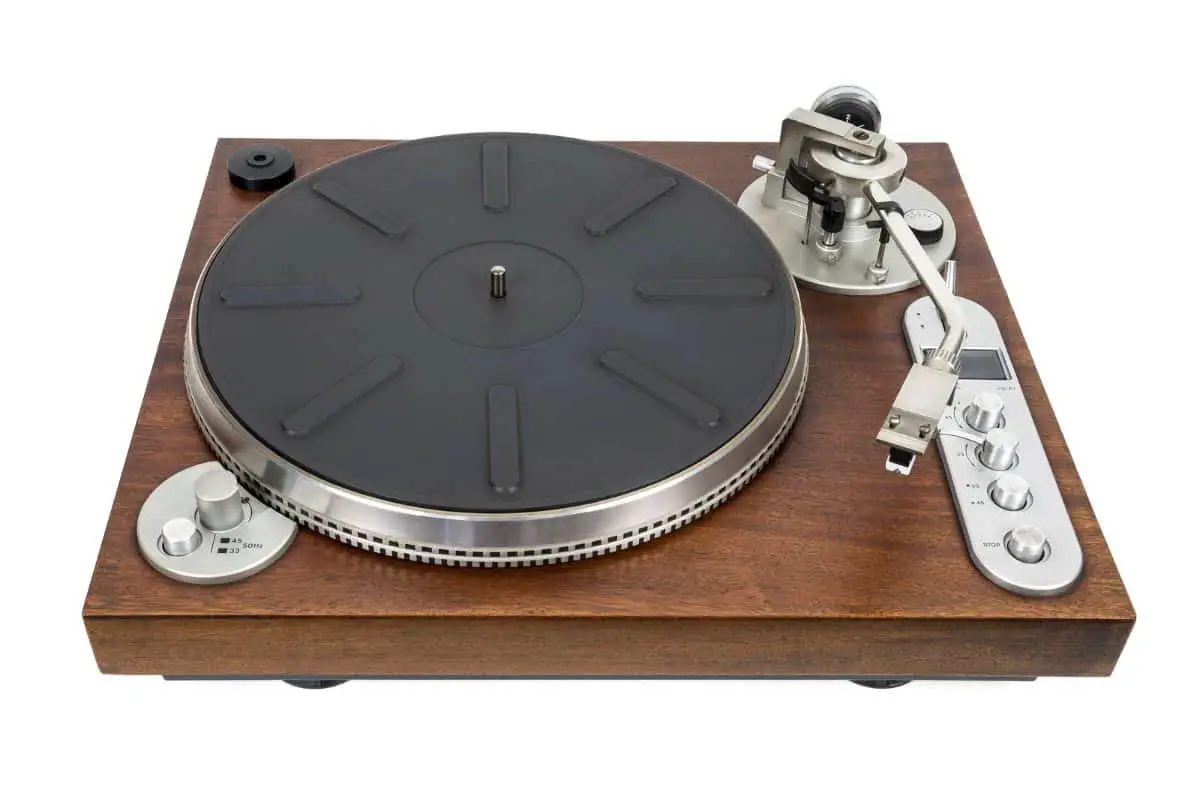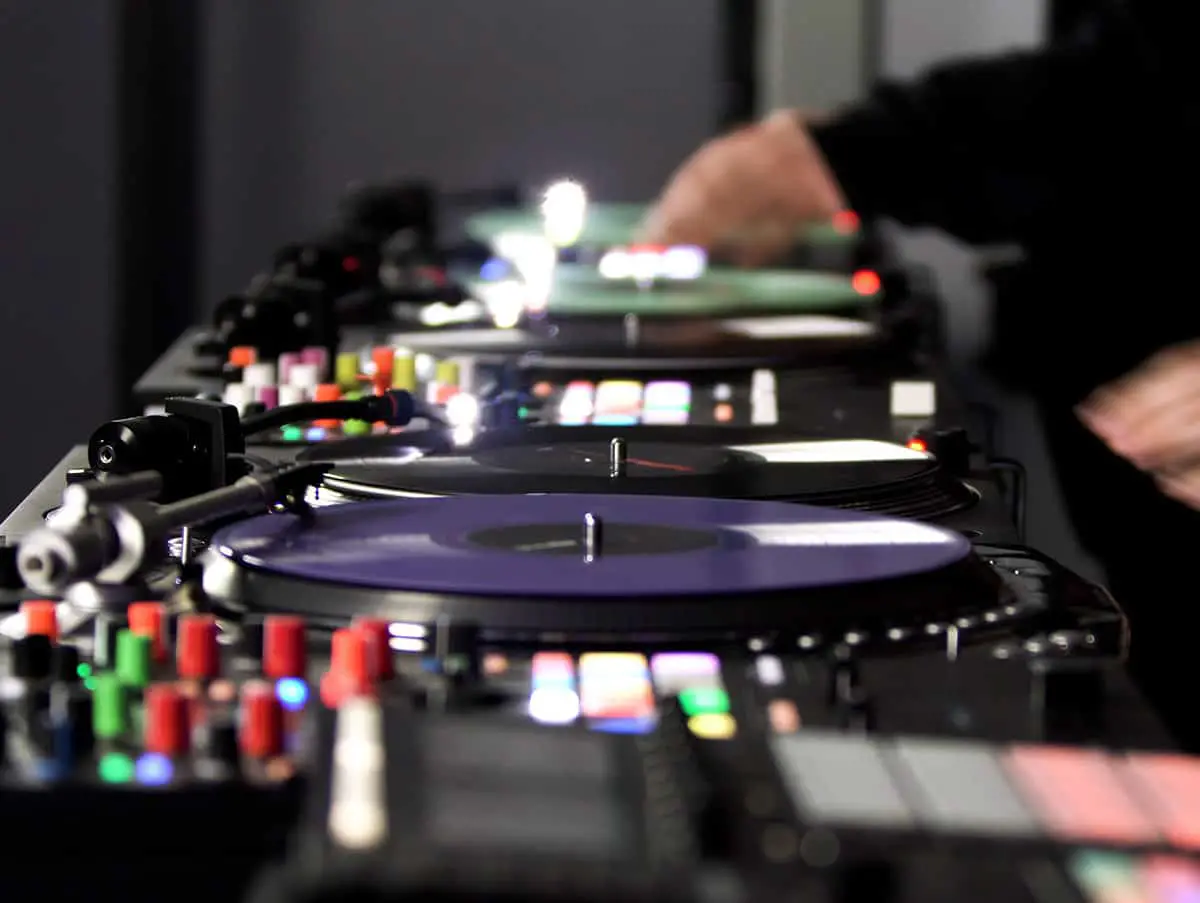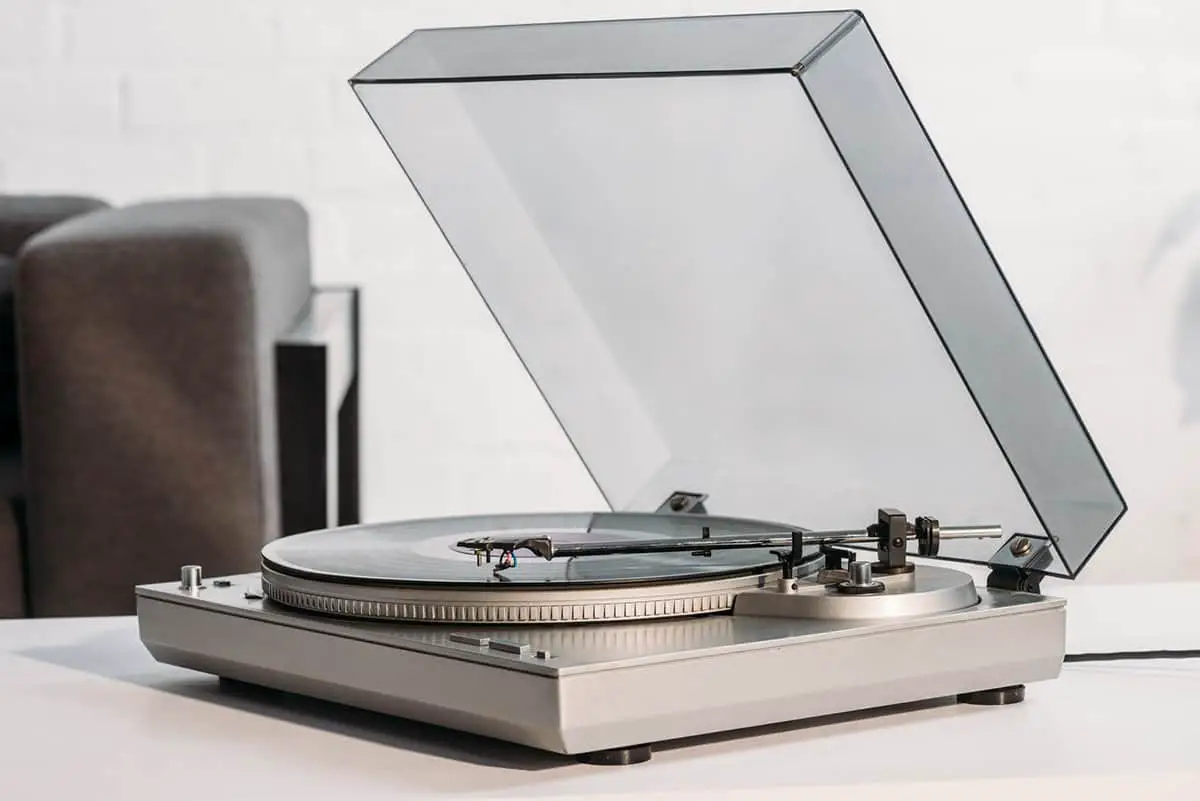This post contains affiliate links.

High-quality turntables are often expensive because of their setup. All the parts need to be top-notch, and even then, they can malfunction. Finding a good deal on a turntable these days can seem like mission impossible – but not if you know where to look.
Turntables are expensive on account of the manufacturing of their numerous segments. Servicing and maintenance of turntables are essential for their optimal performance. Finding the best value for money is attainable through online and in-person auctions.
There are plenty of modern turntables on the market right now that comes at a reasonable price. It is because of the boom that vinyl has experienced in the last decade or so. Music lovers returned to this nostalgia-inducing medium, and they need the equipment to be able to take part.
On the other hand, vintage record players have a different presence. Most brands have stopped producing them decades ago, so buying them second-hand is the most logical choice.
Music shops that specialize in restoration sometimes offer old-school decks. Browsing through various markets and yard sales is your next best bet for locating a pristine vintage record player.
The most crucial thing to bear in mind here is the state of the individual turntable parts. You can come across a preserved table that has a faulty motor you can’t service. It is why you first have to get acquainted with the various components that make a record player.
Table of Contents
Turntable Replacement Parts
To avoid spending tons of money at your local turntable repair shop, get a firm grip on the ins and outs of your musical companion. A typical record player has a dozen parts, most notable being: the motor, the cartridge, the stylus, the tonearm, the (pre)amplifier, and the platter.
There is always work you can do on your turntable so it can perform at its best. To avoid ruining your vinyl, you should keep a close eye on specific parts, such as the cartridge and the stylus.
Always pay attention to strange sounds coming from the motor and stop the turntable if you hear anything unusual.
As for the other parts, don’t fix something that isn’t necessarily broken in the first place. The tonearm and the platter are usually the parts of the turntable that don’t get broken easily.
The amps and the preamps can cause you some trouble, but they are unchallenging. Look up the costs for getting new ones if the old ones stop working.
Be observant of the pieces that are in direct contact with your records. Perceive the turntable separately from the vinyl it plays, although they work in tandem.
Turntable Motor
First things first, make a note of the type of turntable you’ve got on your hands. The two main types are belt-drive and direct-drive, which differ in ways of spinning the platter. (1)
Belt drives are preferred in vintage turntables. The belt isolates the motor from any unwanted vibrations, as well as variations in speed. Direct drives have more robust motors since they power them without any additional parts in between. (1)
Taking care of a record player’s motor resembles taking care of any motor-powered device. You should always have some motor oil on hand for the belt-driven models. Direct-driven turntables don’t need any due to the way of assembly. They should function fine without any extra help from your side. (1)
Make sure to keep the motor clean from any dust, dirt, or debris. A thorough wipe with a cloth now and then does the trick.
Cartridge
A cartridge is a part of the tonearm, one of the vital parts of the turntable. It determines the quality of sound produced, as the stylus on its end transmutes the groove of the recording to sound.
There are two main types of cartridges, both magnetic: the moving magnet cartridge and the moving coil cartridge. Moving magnet cartridges feel lighter on vinyl than the moving coil cartridges. The stylus is easy to remove, so you can switch it up between different types of styli as you wish. (2)
Moving coil cartridges have the coils moving when the stylus gets close to the record, and they have more precision than magnets alone. In turn, the sound is cleaner, so you can expect to find these cartridges on upscale record players. It means they cost more, too. (2)
Since the coils aren’t as heavy as magnets, turntables with moving coil cartridges need an additional step-up transformer. In this case, you can’t replace the stylus on your own – you need to send the entire cartridge to the shop. (2)
Make a note of how the cartridge mounts to the tonearm as well. You can go either for the standard half-inch or the P-mount cartridge mount. If unsure, check with the factory which setting is the best one for your turntable.
Choosing the correct cartridge comes down to what you’re looking for in your record player. The costlier option results in a better audio experience, but the inexpensive one might not give you what you’re looking for. It seems to be a rule of thumb for all turntable parts.
Stylus
The stylus or the needle that comes on top of the cartridge is the thing that can damage your record collection most severely. Because it moves within the grooves of the record, you must change it regularly. Otherwise, tiny particles of dust can get stuck within, ruining your beloved records for good.
Styli come in four main shapes that help you distinguish between them: elliptical, conical, fine line, and microline.
The elliptical stylus comes with a polished tip, so its contact with the grooves is smooth. Its price is mid-range, but it can be hard to replace on your own. (3)
The conical stylus falls heavier on the recording. It is the most common type of stylus out there, so it’s usually not that expensive. It’s pretty easy to replace it, so it’s excellent for beginners. (3)
The fine line (or the shibata) stylus is easy to recognize because it’s shaped like a diamond. It falls very gently on the record due to its lightness, but it comes with a higher price.
The microline stylus is the most precise out of all the styli, and the most expensive one. Don’t consider replacing it by yourself – it’s quite a process. (3)
Replacing both the cartridge and the stylus is a delicate procedure. You don’t need to change the cartridge as often as you should change your stylus. Measure the next replacement in playing hours – once you hit the 1000 hours mark, change the needle. (3)
When you get to this point comes down to how often you play your records. If you play them each day for a few hours, make sure to change the stylus about once per year. (3)
If you’ve bought your turntable second-hand, it’s best to change the needle straight away. You never know how long the old one has been within the cartridge, and you don’t want to risk damaging your records, do you?
Tonearm
A tonearm is here to support the stylus to find its way in the depths of the record. To do so, it needs to be firm and steady without applying too much pressure.
When it comes to setting up a tonearm, everything counts, from the angle of the cartridge to the sharpness of the needle.
Without the direction of the tonearm, the cartridge would head to the center of the vinyl. That’s where the anti-skate force comes into play, keeping the tonearm unmoving. (4)
Ever since the invention of the gramophone, tonearms have been playing their roles. They have remained unchanged for the most part, serving as a buffer between the turntable and the recording. The difference now is the material used in production.
Carbon fiber is used more and more in the manufacturing of tonearms. It is stiffer and less dense than traditionally used aluminum. (4)
A tonearm isn’t a part of the turntable you should think about replacing. A new tonearm might give you slightly better sound quality, but you have to think about aligning it to your cartridge. Manual turntables could use a change but think about getting a second opinion before doing so.
Turntable Longevity

A turntable lasts as long as you take good care of it. Cheaper turntables come with motors past their expiration date and still work if their owners had looked after them. Fresh out of the factory models will, of course, give you nothing to worry about for a good couple of years.
If you’re a fan of vintage turntables, be careful what you wish for. You might stumble upon a record player in mint condition, only to realize its stylus has never been changed. If you forget to consider this and put your favorite record on, say goodbye to it.
Because a record player consists of multiple interconnected pieces, its longevity depends on them. Check the state of your entire tonearm on the regular, and you should be golden. If you notice any changes to the platter or the motor, take your deck in for maintenance.
The vinyl revival has ensured a plethora of new fans of analog who tend to over-complicate things. Getting all the latest gadgets for their vintage turntables develops into an obsession. Changing the stylus every few months is a must. (5)
It’s one thing to take care of your favorite records, and it’s a whole other to worry over them for no apparent reason. Get all the know-how of your turntable brand of choice, but approach it with common sense.
The situation can also be the other way around. If your vinyl is in poor shape, it’s better to invest in a spherical stylus than an elliptical one. Even if it costs a bit more, you’ll find it’s worth it. In the end, it all comes down to what you want to preserve more. (5)
Setting up your turntable isn’t rocket science, although it may seem so at first. Finding a good deal is the same.
Best Turntable Deals
If you’re looking at buying a turntable at a reasonable price, you have a couple of choices in front of you. The first and the most obvious one is ordering one online.
There are plenty of sales via retail sites, on Amazon, and various marketplaces. Plan to get one this way around special dates, such as Black Friday. (6)
You can find a good deal on a turntable by walking into your local supermarket as well. Don’t expect to find the best quality, though. It is what Hi-Fi shops are for. (6)
Since record players are fashionable once again, you can easily find them in selected audio shops. The knowledgeable staff will be sure to point you in the right direction if you’re in doubt.
Besides great deals, these stores often assemble complete sound systems on their own. You will be going home with a one-of-a-kind turntable for way less than what you’d spend if you were buying each part individually.
What’s particularly convenient about these kinds of spots is you can test the sound for yourself. Spend some time getting to know different turntables and see which one fits you best. It is not a one-size-fits-all, and it shouldn’t have to be.
You can always walk into a flagship store of a turntable manufacturing company. Brands like Dual and Rega offer a myriad of options; you’re bound to find a record player that suits you.
If you’re into vintage turntables, spend some time getting to know your city’s yard sales. They’re your best bet when it comes to purchasing a record player in a solid-state at a fair price.
Finding a decent deal for a turntable shouldn’t have to be a nuisance. Make it into a challenge and browse through multiple routes until you discover something just for you.
Are Expensive Turntables Worth It?
With turntables, like with other devices, you can expect to get quality at a price. There are so many types of turntables for a reason. You won’t see an audiophile jamming to a suitcase record player.
Vintage turntables need a lot of patience and devotion. Sometimes an investment or two as well. Vinyl enthusiasts go into so much trouble because the entire experience is worth it.
Buying a record player means you are in it for the long run. Turntables have been made to last for years to come.
That is why there are so many vintage turntables still around. When every household had one, thinking if it was worth it wasn’t even in question back in the day.
Getting together and listening to records was the best way to spend quality time together. When technology wasn’t as advanced as it is now, entertainment came from a different source. It seems our culture is coming full circle.
Putting the needle down to a recording is more than a way of listening to music; it’s a ritual. It links you, even if just for a few minutes, to an art that is older than you.
The atmosphere that a turntable creates is pleasurable that DJs attempt to recreate it each day and each night. (7)
The renaissance of vinyl is a statement in an overly digitalized society. It came back to show us all how attached we are to the things we value most – and for a lot of us, it’s always been music. Some things never change. Or do they?
Alternatives to Expensive Turntables
You don’t have to pay a lot of money to have a good sound system. You can buy a low or mid-range turntable which will deliver the goods. You can always upgrade it with a good tonearm, amp, or hook it up to a great set of speakers.
Anything worth having doesn’t come easy – and this is especially true with good music. You can always decide on playing your favorite tunes via another medium. Don’t expect you’ll be getting the same treatment you do with record players, though.
The battle of analog versus digital continues. Everyone decides on their preference: a full, warm sound that a turntable makes or a no-fuss, easy-to-share MP3.
You don’t have to choose which one wins the whole game. Mix and match and see where your audio journey will take you to.
Why Are Turntables Expensive?
Turntables have been around longer than any person alive today. They are a part of our history, and we are learning to appreciate them. It is why class A turntables cost a lot, in some cases.
They’re hard to come by, they require proper TLC, but they grow on us. When you find the perfect record player that has that sound you’ve been dreaming of, you’ll be sure to feel it. And there is no price you won’t be willing to pay to continue this relationship.
Resources:
- https://en.wikipedia.org/wiki/Phonograph#Turntable_technology
- https://sumikophonocartridges.com/turntable-cartridge-types/
- https://sumikophonocartridges.com/replacing-stylus/
- https://magazine.vinylmeplease.com/magazine/hows-whys-and-whats-tonearms/
- https://www.nytimes.com/2012/04/19/technology/personaltech/how-to-enjoy-turntables-without-obsessing-over-them.html
- https://vinylrestart.com/where-to-buy-a-turntable-record-player/
- Bartmanski, D., Woodward, I.: “The vinyl: The analogue medium in the age of digital reproduction”
VacationVinyl.com is a participant in the Amazon Services LLC Associates Program, an affiliate advertising program designed to provide a means for sites to earn advertising fees by advertising and linking to Amazon.com. We also participate in other affiliate programs which compensate us for referring traffic.



